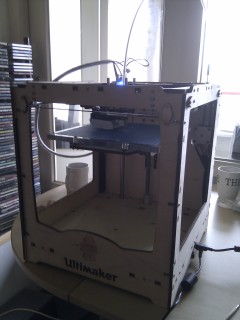Networked Ultimaker with Raspberry Pi (on linux)
2012-08-04 | PermalinkI got my Raspberry Pi yesterday!
Installation of the provided Debian image is a breeze (just make sure you have an SD card and a micro-USB cable lying around). And I am happily playing with it right now.
I didn’t have a real Plan to use it yet, so in the meantime I’m using it to control my Ultimaker over a network; Due to physical constraints, I have my printer in the same room as my main desktop system, but out of reach for any sane USB cable. I have a laptop sitting right next to it to control it now, and I am thinking of getting an [Ulticontroller](https://shop.ultimaker.com/en/parts-and-upgrades/ulticontroll er-ultipanel.html).
But the laptop is slow, and I want to at least be able to send prints from my main machine to the Ultimaker. Also, should I get rid of the laptop, I have more room to stuff tools and prints. It’s getting a bit messy.
So, Use 1 for the Raspberry Pi was born!
Originally I was thinking of writing a fake serial driver, that passed on all data to a fake serial client, running on the Pi, but it turns out that isn’t even necessary; we can use the socat tool.
I have not fully fleshed out all details yet, and there are some current problems, but I thought I’d share.
Basic steps:
- Install socat on client and on raspberry pi
- Connect Raspberry to network
- Connect Raspberry to Ultimaker
- On raspberry, run:
- On client machine, run:
(I used port 12346 for no reason at all)
Go to your controller tool (e.g. PrintRun), and set the port to ~/ttyACM1.
And start printing!
Well, not exactly. While the above works with PrintRun, it does not with Cura.
Cura appears to have a fixed set of possible ports (I can’t edit the field), so we’ll have to use one of the standard names. This presents us with a problem, since in order to use, for instance /dev/ttyACM0, we’ll need to run socat as root. And if we run socat as root, our client (which we will certainly not run as root), can’t connect.
A quick workaround is to change ownership of /dev/ttyACM0 once socat is running;
sudo socat -d PTY,link=/dev/ttyACM0,raw,echo=1,wait-slave tcp:192.168.8.24:12346
chown <your username> /dev/ttyACM0
I suspect there may be some option within socat for this, but I have not looked for it yet.
Obviously, this also ‘opens’ your printer to your entire network. You can also do it without the listening side, though, but you probably want to set up ssh-keys first, so you do not need to enter a password every time. Once you have, you can use something like:
socat PTY,link=~/ttyACM0,raw,echo=1,wait-slave EXEC:'"ssh \
pi@<IP address of raspberry> socat - /dev/ttyACM0,nonblock,raw,echo=0,\
b<your Ultimaker firmware baudrate>"'
There are more issues:
- The socat instances can quit, in which case you need to run them again, so at this point it is not a fire-and-forget kind of initialization.
- I have no idea what will happen if you plug in something that might initialize a serial port itself. I hope socat is nice in registering itself (so the tty will not be assigned to something else), but I have not tried this out.
- You may not want to do this over a flaky WiFi connection.
Anyway, I’m using this to print out a case for my raspberry right now. Let’s see how it goes!
